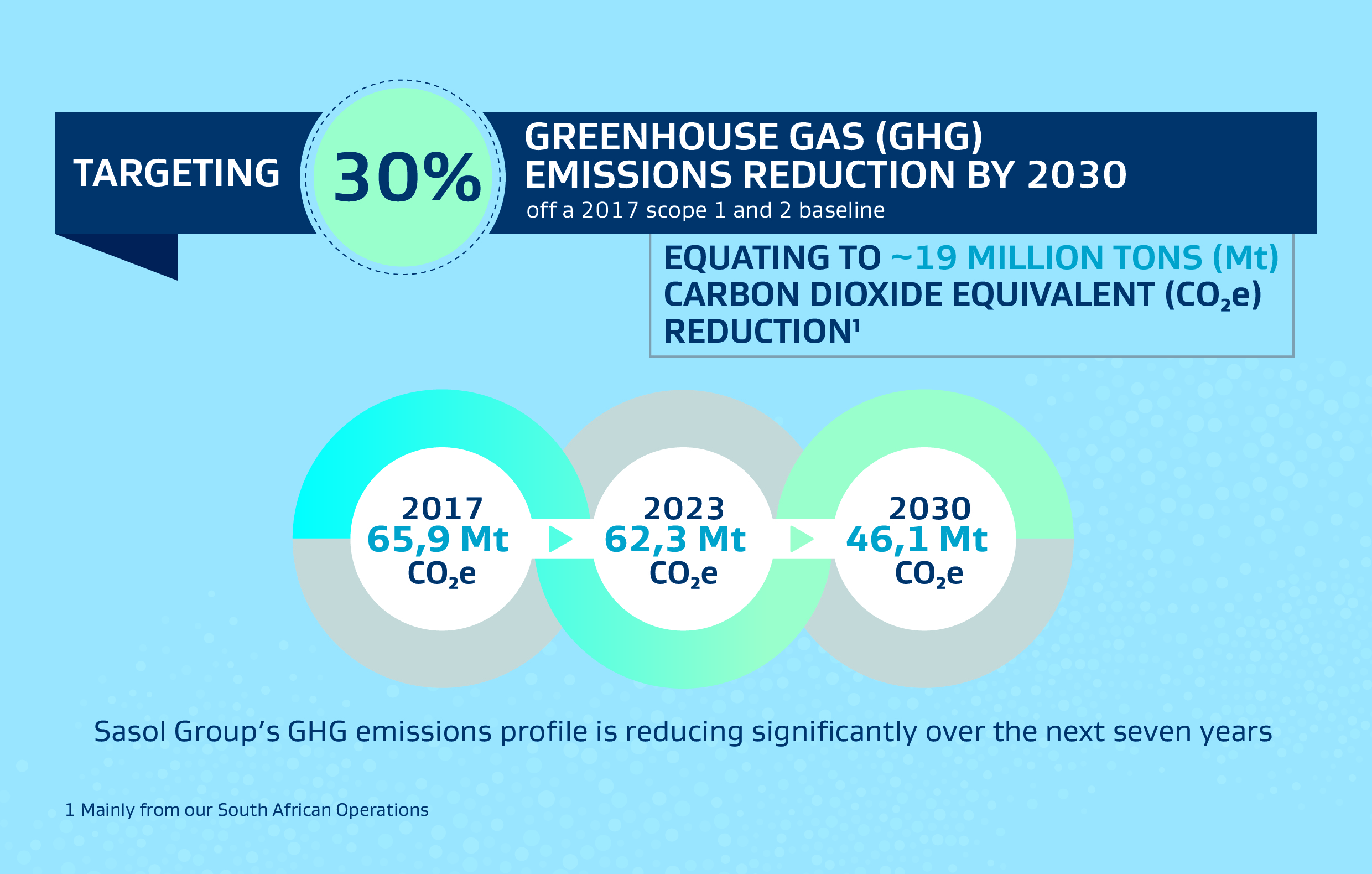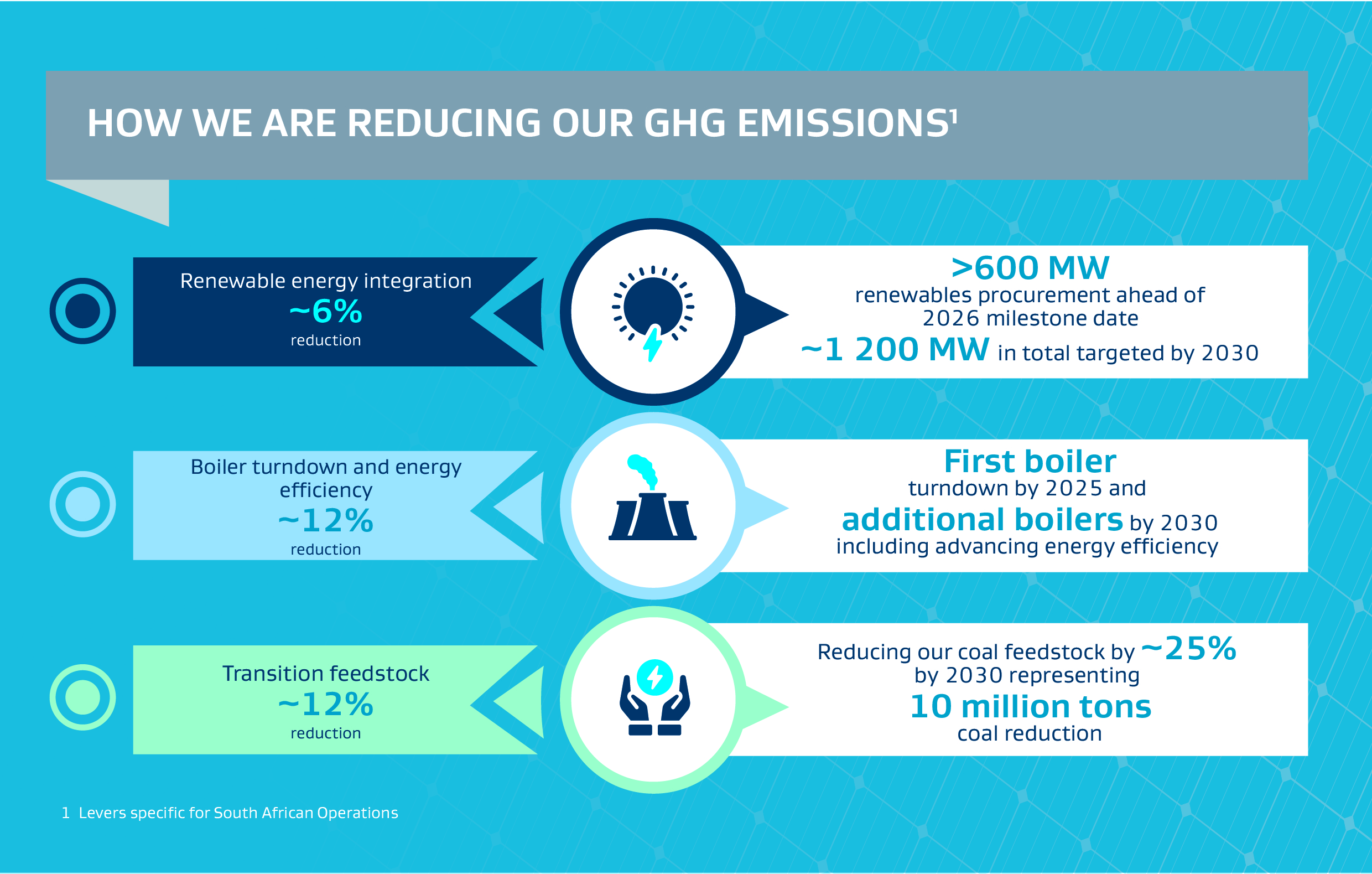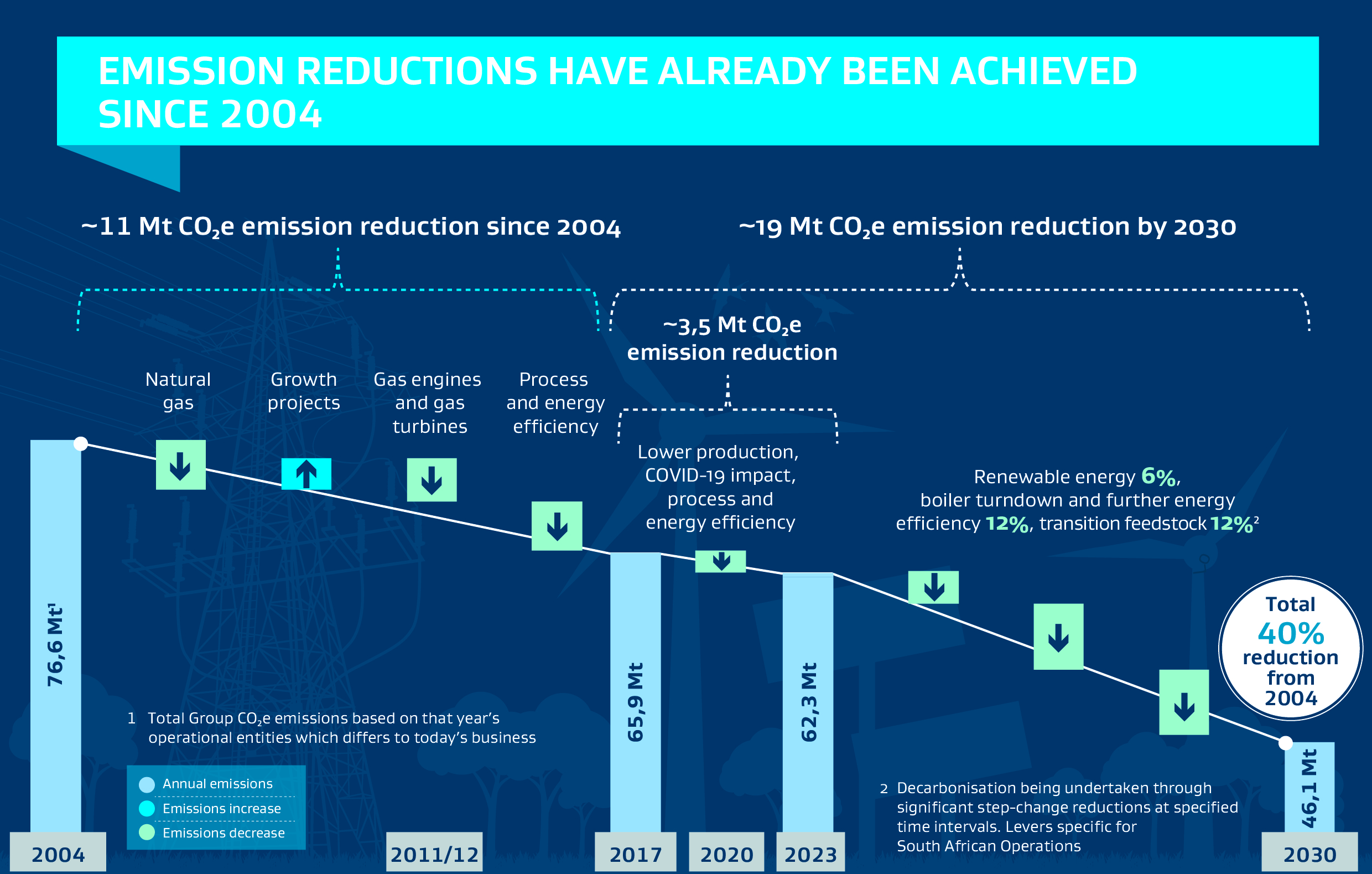- Home
-
Who We Are

Overview
Sasol is a global chemicals and energy company. We harness our knowledge and expertise to integrate sophisticated technologies and processes into world-scale operating facilities. We safely and sustainably source, produce and market a range of high-quality products, creating value for stakeholders.
-
Our Businesses

Overview
Through proprietary technologies and processes the main products Sasol produces are fuel components, chemical components and co-products. From these main products and further value-adding processes we deliver diesel, petrol (gasoline), naphtha, kerosene (jet fuel), liquid petroleum gas (LPG), olefins, alcohols, polymers, solvents, surfactants, co-monomers, ammonia, methanol, crude tar acids, sulphur, illuminating paraffin, bitumen and fuel oil. Even further processing produces numerous additional products.
-
ESG

Overview
Advancing chemical and energy solutions that contribute to a thriving planet, society and enterprise.
-
Investor Centre

Overview
Sasol's investors consist of both equity investors (those invested in the Sasol ordinary shares or the ADRs) and lenders/debt investors (banks and institutional investors lending to Sasol or investing in its issues of debt instruments such as local bonds, offshore bonds, commercial paper issues, project finance, loans and other credit facilities and convertible instruments).
-
Suppliers
- North America
- Sasol Supplier Landscape and Guiding Principles
- Supplier Environment, Social and Governance (ESG)
- Become A Supplier
- Service Provider Safety Management
- Enterprise And Supplier Development
- Existing Supplier Portal
- Contract Terms And Conditions
- Important Links
- Supply Chain Fraud Alert
- Sasol EthicsLine

Overview
Supply Chain is the custodian of all external spend for the Sasol Group. It is responsible for managing supply and demand so as to ensure cost-efficiency and maximise return on spend, while at the same time ensuring effective logistics of a range of deliverables.
-
Careers

Overview
Explore existing opportunities to energise your career to the next level. Whether you are seeking a Learnership or you are Student or Graduate or Experienced Hire. Find out how you can add value to the Sasol Team.
-
Media Centre

Overview
Access media releases and view latest social media updates
- Contact Us
CEO stakeholder letter
CEO stakeholder letter
Stores
|
Total Stores |
Division |
Store Location |
Address |
Tel No |
|
1 |
Relabelled |
Salt River |
29 Brickfield Road, Salt River, Cape Town |
(021)4479913 |
|
2 |
Relabelled |
Bellville |
Shop 4, Corner Voortrekker Rd & Durban RD, Bellville |
(021)9171860 |
|
3 |
Relabelled |
Kenilworth |
Unit number 3 access park, Chichester road, Kenilworth |
(021)6714778, |
|
4 |
Relabelled |
Kuilsrivier |
Shop 4 & 5 Access Park, Kuilsrivier |
(021)9031294 061 287 3980 |
|
5 |
Relabelled |
Mobeni |
Cnr Grimsby & Leicester Rd, Mobeni, Durban |
(031)4620540 W\House (031) 469 9409 |
|
6 |
Relabelled |
Pier 14 |
21A Pier 14, Shopping Centre, Port Elizabeth |
(041)4841575 083 5176 728 |
|
7 |
Relabelled |
Marlboro |
13 Sparten Crescent ,Marlboro , Ext 3 Johannesburg |
(011) 262 0460 |
|
8 |
Relabelled |
Soweto |
Maponya Shop 200 2127 Chris hani Road, klipspruit ext5 Soweto |
(011) 933 1023 |
|
9 |
Relabelled |
Umlazi |
Shop 155 Umlazi Mega City 50 Griffiths Mxenge Highway Umlazi |
(031) 902 1325 |
|
10 |
Relabelled |
Epping |
10 Losack avenue , epping industrial |
(021) 534 0401 |
|
1 |
BCWC |
Kloof |
Lifes on Kloof, 50 Kloof Street, Gardens ,Cape Town, shop G-15 |
(021) 422 1593 078 211 8051 |
|
2 |
BCWC |
Canal Walk |
Shop 619 Canal Walk , Century BLVD, Century City , Cape Town 7441 |
(021) 551 2891 |
|
3 |
BCWC |
Monte Casino |
Shop 80B Montecasino, No1 Monticasino Bouelvard Fourways , 2191 Magents |
(011) 465 0438 |
|
4 |
BCWC |
Menlyn |
Shop UF 42 & 43 cnr atterbury road & lois avenue , menlo park , Pretoria |
(012) 764 9600 |
|
5 |
BCWC |
Balito |
SHOP 608 LEONORA DRIVE,DOLPHIN COAST,BALLITO,4399 |
032 586 0242 |
|
6 |
BCWC |
Rosebank |
Shop GF08, The Zone, Rosebank mall, Oxford Street, Johannesburg |
(011)268 1114 |
|
1 |
Magents |
Canal Walk |
Shop 08 , Century Blvd , Century City 7441 |
(021) 551 2533 JP CELL: 064 686 4026 |
|
2 |
Magents |
Monte Casino |
Shop 21 Montecasino, No1 Monticasino Bouelvard Fourways , 2191 Magents |
(011) 465 6721 074 669 6310 073 804 4352 079 884 7607 |
|
3 |
Magents |
Menlyn |
MENLYN MALL , SHOP G190 CNR ATTERBURY ROAD & LOIS AVENUE,MENLO PARK,PRETORIA |
(012) 348 4725 073 8677 468 - Sieya , kiley , OUPA, Micheal |
|
4 |
Magents |
Balito |
SHOP 608 LEONORA DRIVE,DOLPHIN COAST,BALLITO,4399 |
061 521 7446 032 586 1467 |
|
1 |
WSA |
Menlyn |
MENLYN MALL ,LF41A CNR ATTERBURY ROAD & LOIS AVENUE,MENLO PARK,PRETORIA |
Vicky - 078 816 1921 land line - 012 348 4766 |
|
6 |
BCWC |
Rosebank |
Shop GF08, The Zone, Rosebank mall, Oxford Street, Johannesburg |
(011)268 1114 |
|
1 |
Magents |
Canal Walk |
Shop 08 , Century Blvd , Century City 7441 |
(021) 551 2533 JP CELL: 064 686 4026 |
|
2 |
Magents |
Monte Casino |
Shop 21 Montecasino, No1 Monticasino Bouelvard Fourways , 2191 Magents |
(011) 465 6721 074 669 6310 073 804 4352 079 884 7607 |
|
3 |
Magents |
Menlyn |
MENLYN MALL , SHOP G190 CNR ATTERBURY ROAD & LOIS AVENUE,MENLO PARK,PRETORIA |
(012) 348 4725 073 8677 468 - Sieya , kiley , OUPA, Micheal |
|
4 |
Magents |
Balito |
SHOP 608 LEONORA DRIVE,DOLPHIN COAST,BALLITO,4399 |
061 521 7446 032 586 1467 |
|
1 |
WSA |
Menlyn |
MENLYN MALL ,LF41A CNR ATTERBURY ROAD & LOIS AVENUE,MENLO PARK,PRETORIA |
Vicky - 078 816 1921 land line - 012 348 4766 |

CEO stakeholder letter
Balancing People, Planet, Profit on our pathway to Net Zero
29 November 2023
Dear stakeholders,
The recent disruption to our Annual General Meeting and the fervent discussions that preceded it, reflect the strong interest many have in Sasol and our commitment to climate action.
Notwithstanding the conflicting views about our climate risk management approach, one thing is clear: we share collective interest in South Africa’s just energy transition to a low carbon future and our responsibility as Sasol, both in enabling this and remaining a key pillar of the economy.
To this end, we report extensively on our greenhouse gas (GHG) emissions reduction roadmap and targets, and engage transparently and frequently with a broad range of stakeholders. Our engagements unpack:
- our complex operations that require unique solutions to enable our transition;
- our firm plans that demonstrate commitment and progress in meeting our targets; and
- the pace of our transition, taking into account the need to balance job preservation and sustain our socio-economic contributions, consistent with our just transition focus.
Robust and constructive debate on our decarbonisation efforts is always welcome, as it enables continuous improvement in the shaping and implementation of our plans. Some views about Sasol’s approach have, regrettably, been inaccurate. It is therefore important that we set the record straight.
The starting point is simple. Sasol is committed to our 2030 GHG target and 2050 net zero ambition we announced in 2021. There is no retreat from these goals.
Sasol is a complex, integrated business that owns and operates two main facilities in South Africa – Secunda Operations (coal-to-liquids) and Sasolburg Operations (gas-to-liquids). We emit about 60 million tons (or 12% of the country’s national GHG inventory) of carbon dioxide equivalents (CO2e) – not to be confused with air quality pollutants regulated under South Africa’s Air Quality Act – largely through the processing of 40 million tons of coal, making us the second largest emitter of GHG emissions in South Africa.

We are fully aligned with our stakeholders that our emissions profile must be reduced. Where there is often disagreement, however, is over the speed at which this can reasonably be done in a pragmatic manner. The desire for urgency is understandable, but it can sometimes ignore the imperative of balancing all stakeholders’ needs, while focusing on environmental protection, sustaining our socio-economic contributions, and remaining profitable. Sasol’s Environmental, Social and Governance (ESG) focus is premised on striking a reasonable balance on People, Planet and Profit.
By 2050, Sasol envisages a net zero fossil fuel free operation utilising significant quantities of green hydrogen, renewable energy and sustainable carbon, while producing sustainable aviation fuels and chemicals for global and local markets. This is a very plausible scenario for the future as Sasol is a world leader in Fischer-Tropsch technology that will unlock this.
As a key transition milestone for meeting our 2050 ambition, we are committed to a 30% reduction in GHG emissions (equating to a 19 million ton CO2e reduction) by 2030 collectively for our Secunda and Sasolburg operations. In addition, we have also set short term goals to be achieved by 2026.
While our 2050 net zero ambition pathway is less certain because technologies are not yet economically available or at scale, our 2026 and 2030 transition pathway is rooted in tangible implementation and reduction actions, and is based on known technologies, including:
- optimising energy and process efficiency to reduce overall energy consumption on our sites, to enable the turndown of up to six boilers (one boiler turndown results in approximately 1 million ton of CO2e reduction) and contributing about 12% to our 2030 target;
- replacing Eskom and self-generated power from coal with renewable sources, totalling 1 200 MW by 2030 – one of the largest renewable energy procurement programmes from the private sector in South Africa – and contributing approximately 6% to our 2030 target. To date, we have already procured more than 600 MW of renewables for integration as early as end financial year 2025, representing more than 50% of our renewable energy goal; and
- reducing our coal feedstock by about 25%, representing a 10 million ton reduction of coal, and contributing approximately 12% to our 2030 target, which reduces annual liquid fuels and chemicals production from Secunda Operations, on-average, from 7,2 to 6,7 million tons in 2030. Sourcing gas (we have invested more than US$1 billion in extending the lifetime of our gas resources in Mozambique) and sustainable sources of carbon is a priority to restore production volumes, but is not needed to achieve the 30% GHG reduction target.

These tangible mitigation interventions demonstrate that our commitment to transition is not just a pledge, it is core to our Future Sasol strategy. Based on a multi-year and multi-disciplinary process, this strategy balances ongoing value creation, support for the Paris Agreement, national climate change and socio-economic imperatives, and enabling a just and equitable transformation that minimises negative socio-economic impacts.
In anticipation of reducing coal feedstock, we are examining interventions used in mine closures and reviewing other actions of our peers and have identified five main levers that show promise in terms of impact, scalability and applicability. These levers entail: facilitating job creation (both internal and external); upskilling and reskilling individuals to take on new job opportunities; facilitating access to jobs; exploring financial support mechanisms; and providing well-being support.
While we will not be able to implement annual GHG reductions, we will keep within a similar overall cumulative emissions budget by 2030 through substantial step-change reductions in our emissions over this period. Our trajectory takes this form because our operations are highly integrated, needing long lead times to implement capital-intensive emission-reduction engineering projects.
We understand that our transformation is not only about reducing emissions, but also creating new sustainable products the world will need, as well as low-carbon sectors that will grow South Africa and create shareholder value. To this end, over and above the already allocated cumulative capital spend of R15 to 25 billion for our emission reduction roadmap, we have invested in South Africa’s first commercial scale green hydrogen production facility in Sasolburg, as one example of our low carbon growth endeavours.
Reducing our emissions is also not a recent imperative. From 2004, Sasol’s GHG emissions reduced by more than 11 million tons CO2e, notwithstanding growing our global operations footprint in the United States. Our past reductions focused on energy and process efficiency, nitrous oxide abatement, and lower carbon feedstock substitution in the form of gas, significantly reducing our carbon footprint.
In terms of air quality, Sasol remains a compliant company, as we currently have valid licences in place in respect of the emission of all pollutants. While our air quality emissions differ from the GHG emissions, delivering on our emission reduction roadmap will have air quality improvement benefits. Sasol’s integrated solution also aligns with emphasis the United Nation’s World Meteorological Organisation places on addressing the climate challenge while improving air quality.

As we progress our transition, we must consider that the value generated by the Secunda facility, alongside our Sasolburg site, contributes materially to South Africa’s economy and society, from making everyday products to substantial socio-economic contributions, including to critical value chains such as agriculture, chemicals and mining. Furthermore, a recent Sasol-commissioned study confirmed our direct, indirect and induced employment contribution is in the order of 500 000 people; and we contribute around 5% to the country’s Gross Domestic Product (GDP).
Sasol has a strong sense of responsibility and we are firmly committed to helping South Africa achieve a successful transition. We are working at pace to further develop and implement our emissions reduction roadmap, and options for future low carbon value pools, with significant capital and resources allocated to deliver our transition and ultimately to reinvent Sasol.
We continue to invest in research and development with, by far, the largest investment being in our worldwide in-house research facilities. Recently, we established a Future Technologies team to identify, assess, develop, protect and integrate novel technology options, innovations and advancements setting a strong foundation to support the achievement of our 2050 net zero ambition. Approximately R180 million has been allocated towards decarbonisation related projects within our Research and Technology function, equating to roughly 25% of its annual total budget.
In closing, let me reiterate that we understand the urgency of addressing climate change, while preserving socio-economic stability. We are wholeheartedly committed to meeting these imperatives, in the interests of all our stakeholders.
As always, we remain available for constructive and responsible engagements, that accord all parties equal respect and a right to be heard. While we may differ in our approaches and expectations, we are working towards the same goal and intent: balancing People, Planet and Profit objectives for the benefit of our country.
Sincerely,

Fleetwood Grobler
President and Chief Executive Officer Sasol Limited

